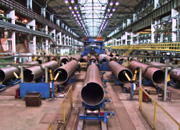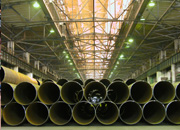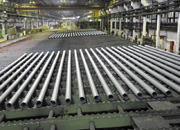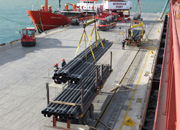Home - News > Industry NewsIndustry News
What are the steps of post-weld heat treatment of steel pipes
Update:2025-04-27 View(s):619 Keywords :steel pipe heat treatment, steel pipe machining, steel pipe post weld
Post-weld heat treatment of steel pipes is also called dehydrogenation treatment. The purpose of post-heat treatment of the weld area of the steel pipe immediately after welding is to reduce the hardness of the weld area of the steel pipe, or to remove harmful substances such as hydrogen in the weld area of the steel pipe. In this regard, post-heating and post-weld heat treatment of steel pipes are partially the same. Post-weld heat treatment of steel pipes is beneficial to the reduction of the cooling rate of the weld and welded joint of the steel pipe, which promotes the escape of hydrogen and avoids the increase of hardness.
1. Post-heating for the purpose of improving the performance of the welded joint and reducing its hardness must be carried out when the welding area is still at a higher temperature after welding to be effective.
2. Post-heating for preventing low-temperature cracks is mainly to promote the full removal of hydrogen in the weld area of the steel pipe. The removal of hydrogen depends on the temperature and insulation time of post-heating. The temperature for dehydrogenation is generally 200-300 degrees, and the post-heating time is 0.5-1 hour.
Post-weld heat treatment of steel pipes
Step 1: Thickness greater than 32mm, and standard tensile strength σb>540MPa;
Step 2: Low alloy steel materials with a thickness greater than 38mm;
Step 3: Butt welds between embedded pipes and pressure vessels;
Step 4: Welding process assessment to determine those that require hydrogen removal treatment.
Post-weld heat treatment temperature formula for steel pipes
Formula 1: Tp=455.5[Ceq]p-111.4
Formula 2: [Ceq]p=C+0.2033Mn+0.0473Cr+0.1228Mo+0.0292Ni+0.0359Cu+0.0792Si-1.595P+1.692S+0.844V
[Note] Tp——Post-heating temperature ℃; [Ceq]p——Carbon equivalent formula.
Reducing the hydrogen content in the welding zone is one of the important effects of post-heat treatment. It is reported that at 298K, the process of hydrogen diffusion from low-carbon steel welds takes 1.5-2 months.
When the temperature is increased to 320K, this process can be shortened to 2-3 days and nights, and after heating to 470K, it takes 10-15 hours. The main function of post-heating and dehydrogenation treatment is to prevent the formation of cold cracks in the weld metal or heat-affected zone.
When preheating of steel pipes before welding is not enough to prevent the formation of cold cracks, such as in the welding of high-constraint joints and difficult-to-weld steel pipes, the post-heating process must be used to reliably prevent the formation of cold cracks.
 Threeway Steel is known as a professional supplier engaged in manufacturing and distributing a wide range of steel pipe, and our headquarter located the central part of China – Hunan and six associated factories throughout China.
Threeway Steel is known as a professional supplier engaged in manufacturing and distributing a wide range of steel pipe, and our headquarter located the central part of China – Hunan and six associated factories throughout China.
 Threeway Steel is known as a professional supplier engaged in designing, manufacturing and distribution of a wide range of steel products with the headquarter located the central part of China – Hunan and six associated factories throughout China.
Threeway Steel is known as a professional supplier engaged in designing, manufacturing and distribution of a wide range of steel products with the headquarter located the central part of China – Hunan and six associated factories throughout China.
 Threeway Steel is known as a professional supplier engaged in designing, manufacturing and distribution of a wide range of steel products with the headquarter located the central part of China – Hunan and six associated factories throughout China.
Threeway Steel is known as a professional supplier engaged in designing, manufacturing and distribution of a wide range of steel products with the headquarter located the central part of China – Hunan and six associated factories throughout China.
 Threeway Steel is known as a professional supplier engaged in designing, manufacturing and distribution of a wide range of steel products with the headquarter located the central part of China – Hunan and six associated factories throughout China.
Threeway Steel is known as a professional supplier engaged in designing, manufacturing and distribution of a wide range of steel products with the headquarter located the central part of China – Hunan and six associated factories throughout China.
 Threeway Steel is known as a professional supplier engaged in designing, manufacturing and distribution of a wide range of steel products with the headquarter located the central part of China – Hunan and six associated factories throughout China.
Threeway Steel is known as a professional supplier engaged in designing, manufacturing and distribution of a wide range of steel products with the headquarter located the central part of China – Hunan and six associated factories throughout China.

